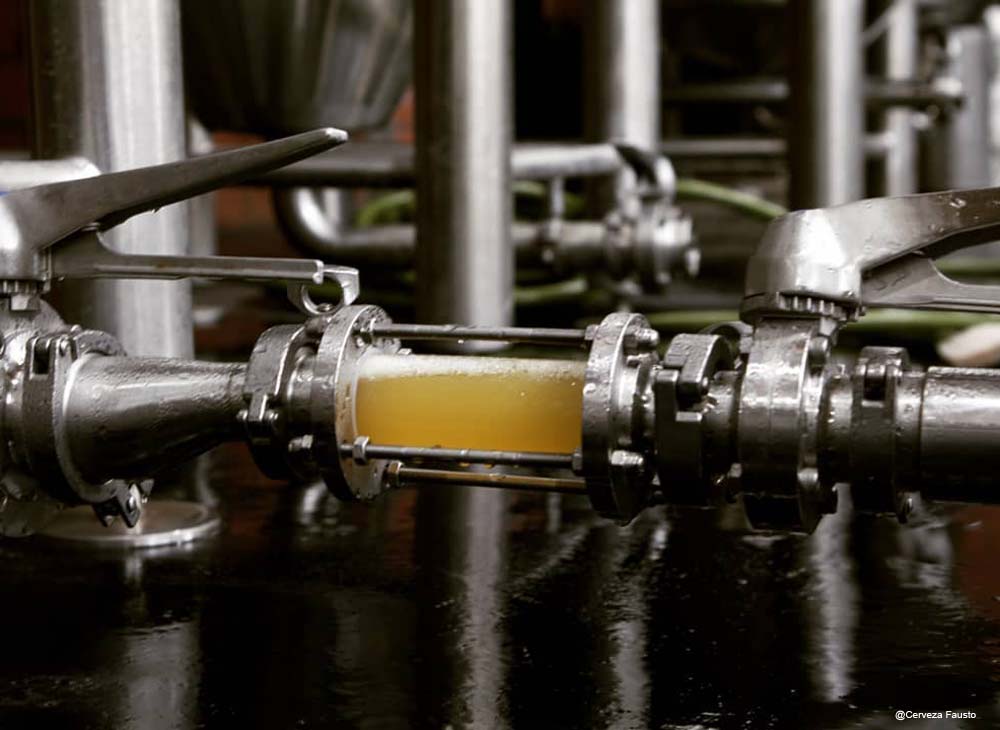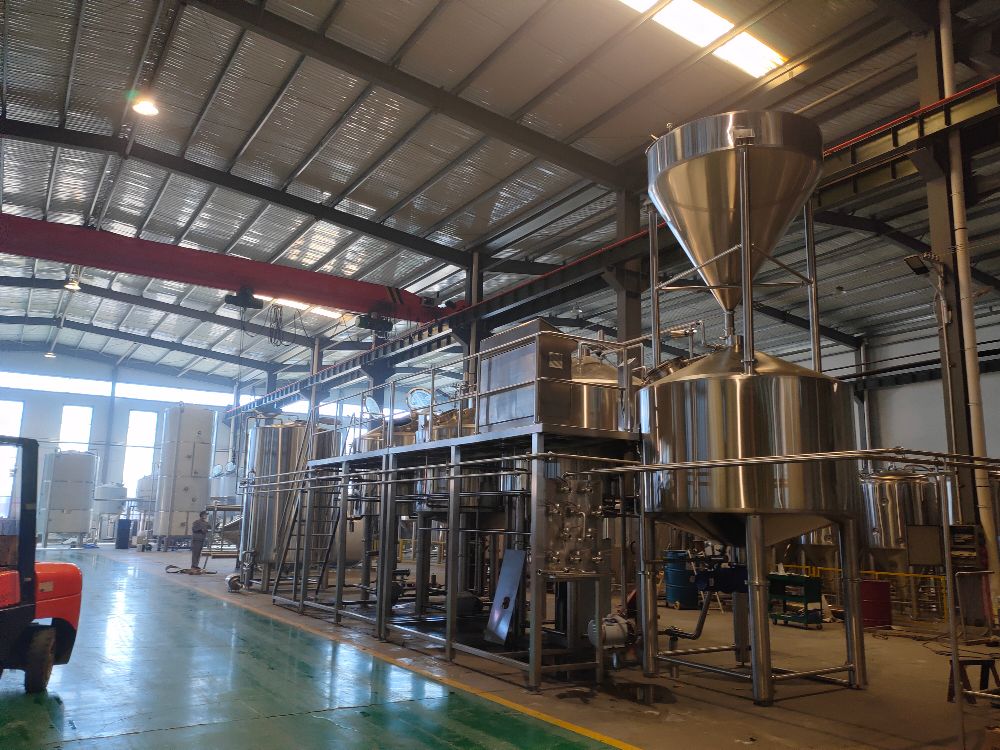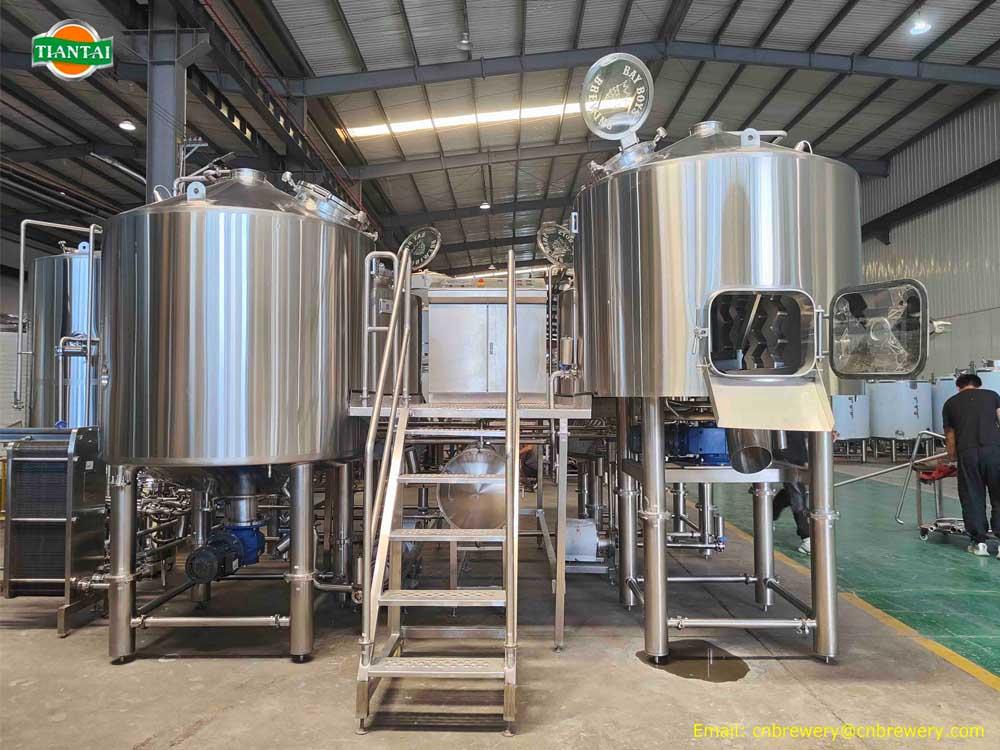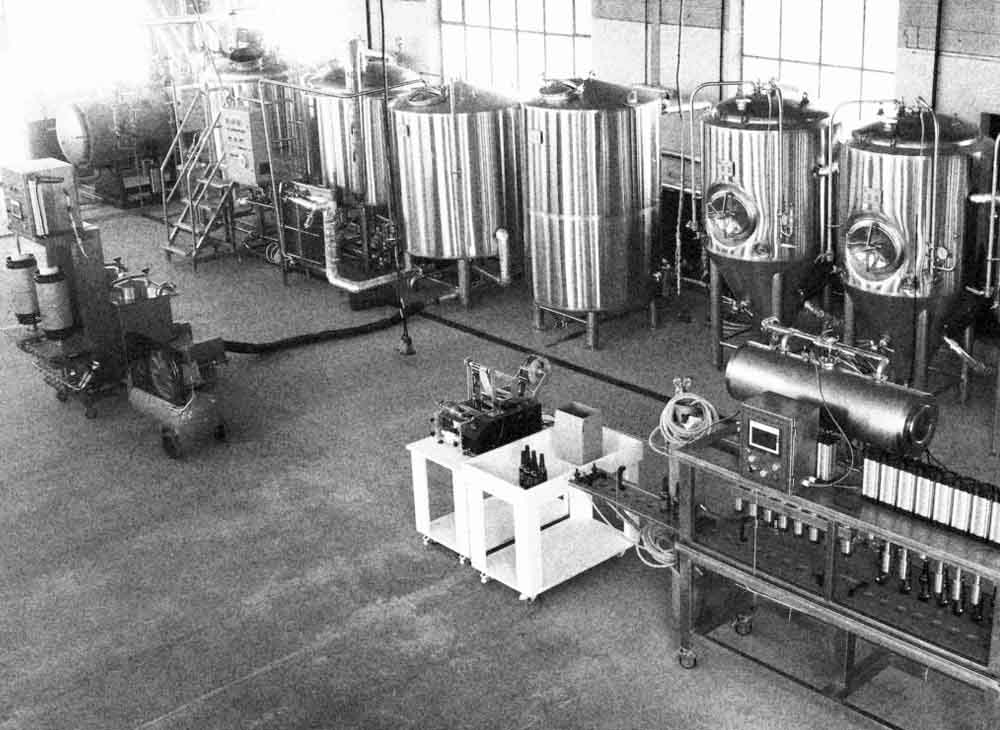The Complete Guide on How to Brew Beer Better (II)
- Dec 04, 2021
- 155
- tiantai
Mash filters
A mash filter steps in where the lauter tun would be. While the lauter tun uses gravity to separate the wort from the grain, a mash filter is more complex than that. It has 45 chambers and uses pneumatics and pressure to push wort through a filter in each of those chambers until the grain is separated from it. Mash filters are pricey, but thanks to them, you can experiment with brews made from 100% rye, oats, or any other grain without added barley to prevent gumming up the equipment.
Precise CO2 control
Figuring out the exact amount of CO2 in your tanks is not an easy task. You mostly have to rely on your gut feeling, which can result in either wasting CO2 if you switch out a tank too soon, or under-carbonating your batch of beer if you switch it out too late. A combination of regulators and valves that automizes the distribution of CO2 could be the solution to properly carbonate the beer. It will help you see precisely how much CO2 you have left in each tank and when you need to replace them. This can drastically reduce the number of CO2 containers you need without interfering with your brewing process in the least.
Compact palletizers
For the same reasons we advocate installing conveyor systems, we also encourage you to consider compact palletizers in your brewery. Manual palletizing is a stressful process for an average worker, and the risk of injury is considerable. It also takes up a lot of time you could save by using a machine instead of a person to do the palletizing for you. Many brands offer their compact palletizers, and you are bound to find one that fits your budget and floor space.
Digital labels
Finally, a digital labeling system may be just what you need to speed up (and improve) your labeling process. If you’re outsourcing your labeling, it could save you money to own your labeler that you can use whenever you want. A personal labeler is especially convenient if you’re producing experimental and limited-edition batches that need unique labels for a short period of time. You can play with the design yourself and have your signature label in the blink of an eye!
Brewing Analysis
A crucial step in automation and enhancing the brewing process is data collection, organization, and analysis. To improve something, you need to know what you’re working with and what parameters to follow to track whether your innovations yield positive results.
Brewing software is becoming more and more prevalent in craft brewing. It provides you with insights into your ingredients’ condition, the fermentation temperature in your fermentation vessel, the pH levels, alcohol content, the consistency of your batches, and so much more. Advanced brewing is about gathering information on how your brewery works and adjusting until you get something as close to perfection as it can be.
Through the use of brewing analysis tools, you can:
Validate data in real time – Real-time validation of data allows you to react quickly if there is a problem. Software keeps track of the brewing process as it unfolds. If there is a kink in the system, you will know about it immediately, which will help you solve it more quickly. Real-time validation is crucial in preventing your batches from spoiling.
Increase batch consistency – The beauty of the constant influx of data and sorting through it in an orderly, systematic way is that you can easily spot sources of inconsistencies among your batches. Brewing software monitors important parameters across all batches. It is only a matter of comparing the information from one batch to another to understand what could be going wrong and what you need to fix.
Analyze the level of efficiency – Assessing how efficient you are in your brewing is difficult. Dozens of calculations are involved – the cost of a batch, how much you profit from a unit, how much product or ingredients you wasted, and more. Brewers often resort to using average numbers for these figures, even though it is important to take into account the actual values. Software will do all the calculations for you, with the precise numbers, offering you the data you need to compare costs, price new products, and see which areas need an efficiency boost.
Track KPIs – Finally, tracking KPIs (key performance indicators) in any process is vital if you wish to brew a better batch of beer. Instead of racking your brain over which KPIs you should observe for every process or change you implement, choose brewing software that will already have these KPIs in place. This way, you will know whether you’re meeting your production goals, if you are wasting too much time on a particular task, or if your ingredients are suffering from any breakage or contamination.
Better Beer Recipes
Installing new equipment, automatizing the brewery, connecting everything with smooth-running software is just one side of the coin. Without an efficient production process, you won’t be able to brew real beer or increase sales. At the same time, the other side of the coin is just as important: the taste of your beer.
Innovation shouldn’t come just in the form of better hardware. You should also look at your beer recipes and flavors to see how you can improve them.
.jpg)
Experiment, experiment, experiment
In the 16th century, Germany (one of the most respected beer centers) passed a regulation that stated that all beer must be made of only four ingredients: cold water, malted barley, malted wheat, and hops. Yeast was accepted as an irreplaceable part of the recipe, even though it wasn’t on the list.
For a long time, beer brewers adhered to these restrictions. Their purpose was to ensure maximum consistency in beer and exclude ‘lesser ingredients’ like corn, rice, sugars, and other grains.
No such law, regulation, or guideline exists today. In fact, craft beers are famous for their one-of-a-kind flavors, daring beer ingredient combinations, and new takes on the well-known beverage. Beer consumers like to rely on their favorite flavors, but they are also looking for new beers to try and new experiences to enjoy. Such adventurous spirit when it comes to beer is what drives the craft beer industry.
To find that beer recipe that speaks to you and your customers, you need to experiment. Limited-edition batches are a good way to test your new ingredient combination and see how the community likes it.
Play around with sweet additives, such as honey, chocolate, or maple, and fruit aromas like orange, apple, banana, raspberry, and others. Spices and herbs also have a place in beer, like cinnamon, ginger, vanilla, coffee, chili pepper, or nutmeg. There are no limits when it comes to experimenting with different types of brewing.
Get into food science
Food science is uncovering the secrets of grain brewing that we still don’t know much about, even thousands of years after the first beers were produced. Scientists are looking at dry yeast and hops, for starters, and at how the entire brewing process works. Their goal is to allow brewers to one day select just the right amount of hops oil or just the right strain of yeast that will give them the exact flavor of beer they’re after.
Some of the recent discoveries in food science are related to hops. Different hop varieties produce oils of different potency levels. It is no longer true that the more hops you add to a brew, the more bitter it will taste. Food science is hoping to learn what type of hops gives what type of flavor so that one day you will have no problem putting together a recipe according to your tastes.
Finally, take a look at the yeast starters and yeast cells you are using. A detailed guidebook to yeast published in 2016 offers insight into what strain of Saccharomyces cerevisiae is good for baking and brewing, and what you can expect if you switch your yeast. The one you’re using right now may be good for your current needs, but it doesn’t mean it’s the best strain of yeast in general. Like with recipes, experimenting with food science can potentially unlock a world of new beer aromas that your customers will be eager to try.
Conclusion
As evident from the entirety of this post, there is no one road to better brewing. The changes you will make in your brewery depend on your budget and what your goals are. Do you want to attract more customers? Reduce wasted product? Do you wish to expand your brewery or maybe reduce the number of workplace accidents? All of these require different approaches to the brewing process.
Take a look at your equipment and what could be improved there. Is there a step you can automate to save time and money? Would you benefit from a computer program that will provide you with invaluable information during the process?
Don’t forget to review your beer recipes and see whether you’d like to make some modifications there, too. Experiment and don’t hesitate to go where potentially no one has ever gone before. Brewing beer is all about taking a well-established tradition from the past and putting a modern twist on it that both you and your consumers will enjoy.
Derrick
Sales Manager
[email protected]
Tiantai Beer Equipment
A mash filter steps in where the lauter tun would be. While the lauter tun uses gravity to separate the wort from the grain, a mash filter is more complex than that. It has 45 chambers and uses pneumatics and pressure to push wort through a filter in each of those chambers until the grain is separated from it. Mash filters are pricey, but thanks to them, you can experiment with brews made from 100% rye, oats, or any other grain without added barley to prevent gumming up the equipment.
Precise CO2 control
Figuring out the exact amount of CO2 in your tanks is not an easy task. You mostly have to rely on your gut feeling, which can result in either wasting CO2 if you switch out a tank too soon, or under-carbonating your batch of beer if you switch it out too late. A combination of regulators and valves that automizes the distribution of CO2 could be the solution to properly carbonate the beer. It will help you see precisely how much CO2 you have left in each tank and when you need to replace them. This can drastically reduce the number of CO2 containers you need without interfering with your brewing process in the least.
Compact palletizers
For the same reasons we advocate installing conveyor systems, we also encourage you to consider compact palletizers in your brewery. Manual palletizing is a stressful process for an average worker, and the risk of injury is considerable. It also takes up a lot of time you could save by using a machine instead of a person to do the palletizing for you. Many brands offer their compact palletizers, and you are bound to find one that fits your budget and floor space.
Digital labels
Finally, a digital labeling system may be just what you need to speed up (and improve) your labeling process. If you’re outsourcing your labeling, it could save you money to own your labeler that you can use whenever you want. A personal labeler is especially convenient if you’re producing experimental and limited-edition batches that need unique labels for a short period of time. You can play with the design yourself and have your signature label in the blink of an eye!
Brewing Analysis
A crucial step in automation and enhancing the brewing process is data collection, organization, and analysis. To improve something, you need to know what you’re working with and what parameters to follow to track whether your innovations yield positive results.
Brewing software is becoming more and more prevalent in craft brewing. It provides you with insights into your ingredients’ condition, the fermentation temperature in your fermentation vessel, the pH levels, alcohol content, the consistency of your batches, and so much more. Advanced brewing is about gathering information on how your brewery works and adjusting until you get something as close to perfection as it can be.
Through the use of brewing analysis tools, you can:
Validate data in real time – Real-time validation of data allows you to react quickly if there is a problem. Software keeps track of the brewing process as it unfolds. If there is a kink in the system, you will know about it immediately, which will help you solve it more quickly. Real-time validation is crucial in preventing your batches from spoiling.
Increase batch consistency – The beauty of the constant influx of data and sorting through it in an orderly, systematic way is that you can easily spot sources of inconsistencies among your batches. Brewing software monitors important parameters across all batches. It is only a matter of comparing the information from one batch to another to understand what could be going wrong and what you need to fix.
Analyze the level of efficiency – Assessing how efficient you are in your brewing is difficult. Dozens of calculations are involved – the cost of a batch, how much you profit from a unit, how much product or ingredients you wasted, and more. Brewers often resort to using average numbers for these figures, even though it is important to take into account the actual values. Software will do all the calculations for you, with the precise numbers, offering you the data you need to compare costs, price new products, and see which areas need an efficiency boost.
Track KPIs – Finally, tracking KPIs (key performance indicators) in any process is vital if you wish to brew a better batch of beer. Instead of racking your brain over which KPIs you should observe for every process or change you implement, choose brewing software that will already have these KPIs in place. This way, you will know whether you’re meeting your production goals, if you are wasting too much time on a particular task, or if your ingredients are suffering from any breakage or contamination.
Better Beer Recipes
Installing new equipment, automatizing the brewery, connecting everything with smooth-running software is just one side of the coin. Without an efficient production process, you won’t be able to brew real beer or increase sales. At the same time, the other side of the coin is just as important: the taste of your beer.
Innovation shouldn’t come just in the form of better hardware. You should also look at your beer recipes and flavors to see how you can improve them.
.jpg)
Experiment, experiment, experiment
In the 16th century, Germany (one of the most respected beer centers) passed a regulation that stated that all beer must be made of only four ingredients: cold water, malted barley, malted wheat, and hops. Yeast was accepted as an irreplaceable part of the recipe, even though it wasn’t on the list.
For a long time, beer brewers adhered to these restrictions. Their purpose was to ensure maximum consistency in beer and exclude ‘lesser ingredients’ like corn, rice, sugars, and other grains.
No such law, regulation, or guideline exists today. In fact, craft beers are famous for their one-of-a-kind flavors, daring beer ingredient combinations, and new takes on the well-known beverage. Beer consumers like to rely on their favorite flavors, but they are also looking for new beers to try and new experiences to enjoy. Such adventurous spirit when it comes to beer is what drives the craft beer industry.
To find that beer recipe that speaks to you and your customers, you need to experiment. Limited-edition batches are a good way to test your new ingredient combination and see how the community likes it.
Play around with sweet additives, such as honey, chocolate, or maple, and fruit aromas like orange, apple, banana, raspberry, and others. Spices and herbs also have a place in beer, like cinnamon, ginger, vanilla, coffee, chili pepper, or nutmeg. There are no limits when it comes to experimenting with different types of brewing.
Get into food science
Food science is uncovering the secrets of grain brewing that we still don’t know much about, even thousands of years after the first beers were produced. Scientists are looking at dry yeast and hops, for starters, and at how the entire brewing process works. Their goal is to allow brewers to one day select just the right amount of hops oil or just the right strain of yeast that will give them the exact flavor of beer they’re after.
Some of the recent discoveries in food science are related to hops. Different hop varieties produce oils of different potency levels. It is no longer true that the more hops you add to a brew, the more bitter it will taste. Food science is hoping to learn what type of hops gives what type of flavor so that one day you will have no problem putting together a recipe according to your tastes.
Finally, take a look at the yeast starters and yeast cells you are using. A detailed guidebook to yeast published in 2016 offers insight into what strain of Saccharomyces cerevisiae is good for baking and brewing, and what you can expect if you switch your yeast. The one you’re using right now may be good for your current needs, but it doesn’t mean it’s the best strain of yeast in general. Like with recipes, experimenting with food science can potentially unlock a world of new beer aromas that your customers will be eager to try.
Conclusion
As evident from the entirety of this post, there is no one road to better brewing. The changes you will make in your brewery depend on your budget and what your goals are. Do you want to attract more customers? Reduce wasted product? Do you wish to expand your brewery or maybe reduce the number of workplace accidents? All of these require different approaches to the brewing process.
Take a look at your equipment and what could be improved there. Is there a step you can automate to save time and money? Would you benefit from a computer program that will provide you with invaluable information during the process?
Don’t forget to review your beer recipes and see whether you’d like to make some modifications there, too. Experiment and don’t hesitate to go where potentially no one has ever gone before. Brewing beer is all about taking a well-established tradition from the past and putting a modern twist on it that both you and your consumers will enjoy.
Derrick
Sales Manager
[email protected]
Tiantai Beer Equipment




